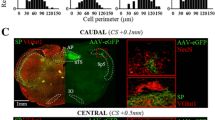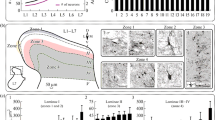Abstract
-
1.
The effects of chronic deafferentation, 3–180 days, are tested on the function and morphology of the crab (Carcinus maenas) ventilatory central pattern generator (CPGv). Almost all afferent axons are carried in the mixed sensory/motor levator nerve. The ability to speed the CPGv cycle rate by stimulating this nerve (Wilkens and DiCaprio 1994) decreases as the afferent neurons degenerate. Stimulation of the levator nerve eliminates motor units from the output even after 60 days of deafferentation, similar to the effects seen in acute preparations.
-
2.
The 3 oval organ afferent axons of the levator nerve have central somata and survive scaphognathectomy. Impulses carried by these axons are known to inhibit the CPGv in acutely deafferented preparations and they are believed to be responsible for the persistent inhibition following small afferent degeneration seen here.
-
3.
After 6 months of deafferentation the motor neuron collateral arborization densities within the thoracic ganglia are reduced, but all motor neurons appear to survive. These long-term deafferented CPGvs generate accurate motor patterns at similar rates to the control CPGv, but at reduced intraburst spike frequency. The crab CPGv is quite stable following chronic deafferentation.
Similar content being viewed by others
Abbreviations
- CPGv :
-
ventilatory central pattern generator
- DN:
-
depressor nerve
- LN:
-
levator nerve
- SN:
-
endite nerve
- SG:
-
scaphognathite
- MN:
-
motor neuron
- OO:
-
oval organ
References
Atwood HL, Lnenicka GA (1988) Role of activity in determining properties of the neuromuscular system in crustaceans. Am Zool 27:977–989
Atwood HL, Dudel J, Feinstein N, Parnas I (1989) Long-term survival of decentralized axons and incorporation of satellite cells in motor neurons of rock lobsters. Neurosci Lett 101:121–126
Bacon JP, Altmann JS (1977) A silver intensification method for cobalt filled neurones in whole mount preparations. Brain Res 128:359–363
Bässler U (1986a) On the definition of central pattern generator and its sensory control. Biol Cybern 54:65–69
Bässler U (1986b) Afferent control of walking movements in the stick insect Cunicula impigra. II. Reflex reversal and the release of the swing phase in the restrained foreleg. J Comp Physiol A 158:351–362
Benshalom G, White EL (1988) Dendritic spines are susceptible to structural alterations induced by degeneration of their presynaptic afferents. Brain Res 443:377–382
Bittner GD (1988) Long term survival of severed distal axonal stumps in vertebrates and invertebrates. Am Zool 28:1165–11799
Bittner GD, Johnson AL (1974) Degeneration and regeneration in crustacean peripheral nerve. J Comp Physiol 89:1–21
Brodfuehrer PD, Hoy RR (1988) Effect of auditory deafferentation on the synaptic connectivity of a pair of identified interneurons in adult field crickets. J Neurobiol 19:17–38
Delcomyn F (1980) Neural basis of rhythmic behavior in animals. Science 210:492–498
DiCaprio RA, Fourtner CR (1984) Neural control of ventilation in the shore crab, Carcinus maenas. I. Scaphognathite motor neurons and their effect on the ventilatory rhythm. J Comp Physiol A 155:397–405
Edwards JS, Palka J (1974) The cerci and abdominal giant fibres of the house cricket, Acheta domesticus. I. Anatomy and physiology of normal adults. Proc R Soc Lond B 185:83–103
Govind CK, Pearce J (1988) Remodeling of nerves during claw reversal in adult snapping shrimps. J Comp Neurol 268:121–130
Govind CK, Pearce J, Potter DJ (1988) Neural attrition following limb loss and regeneration in juvenile lobsters. J Neurobiol 19:667–680
Govind CK, Blundon JA, Kirk MD (1992) Functional degeneration of isolated central stumps of crayfish sensory axons. J Comp Neurol 322:111–120
Grillner S (1985) Neurological bases of rhythmic motor acts in vertebrates. Science 228:143–149
Hoy RR, Nolen TG, Casaday GC (1985) Dendritic sprouting and compensatory synaptogenesis in an identified interneuron follow auditory deprivation in a cricket. Proc Natl Acad Sci USA 82:7772–7776
Lnenicka GA, Atwood HL (1988) Long-term changes in neuromuscular synapses with altered sensory input in a crayfish motoneuron. Exp Neurol 100:437–447
McMahon BR, Wilkens JL (1977) Periodic respiratory and circulatory performance in the red rock crab Cancer productus. J Exp Zool 202:363–374
Mendelson M (1971) Oscillator neurons in Crustacean ganglia. Science 171:1170–1173
Moffett S (1977) Neuronal events underlying rhythmic behavior in invertebrates. Comp Biochem Physiol 57:187–195
Murphey RK (1986) Competition and the dynamics of axon arbor growth in the cricket. J Comp Neurol 251:100–110
Murphey RK, Lemere CA (1984) Competition controls the growth of an identified axon arborization. Science 224:1352–1355
Murphey RK, Levine RB (1980) Mechanisms responsible for changes observed in response properties of partially deafferented insect interneurons. J Neurophysiol 43:367–382
Palka J, Edwards JS (1974) The cerci and abdominal giant fibres of the house cricket, Acheta domesticus. II. Regeneration and effects of chronic deprivation. Proc R Soc Lond B 185:105–121
Pasztor VM (1969) The neurophysiology of respiration in decapod Crustacea. II. The sensory system. Can J Zool 47:435–441
Paul DH (1972) Decremental conduction over “giant” afferent processes in an arthropod. Science 176:680–682
Pearson KG (1972) Central programming and reflex control of walking in the cockroach. J Exp Biol 56:321–330
Pearson KG (1987) Central pattern generation: a concept under scrutiny. In: HM Lennan, JR Ledsome, CHS McIntosh, DR Jones (eds) Advances in physiological research. Plenum Press, New York, pp 167–185
Pearson KG, Wolf H (1987) Comparison of motor patterns in the intact and deafferented flight system of the locust. I. Electromyographic analysis. J Comp Physiol A 160:259–268
Rajashekhar KP, Wilkens JL (1992) Dopamine and nicotine, but not serotonin, modulate the crustacean ventilatory pattern generator. J Neurobiol 23:680–691
Rossignol S, Lund JP, Drew T (1990) The role of sensory inputs in regulating patterns of rhythmical movements in higher vertebrates. In: Cohen AH, Rossignol S, Grillner S (eds) Neural control of rhythmic movements in vertebrates. John Wiley, Sons, New York, pp 201–284
Sanes JN, Suner S, Lando JF, Donoghue JP (1988) Rapid reorganization of adult rat motor cortex somatic representation patterns after motor nerve injury. Proc Natl Acad Sci USA 85:2003–2007
Schildberger K, Wohlers DW, Schmitz B, Kleindienst H-U, Huber F (1986) Morphological and physiological changes in central auditory neurons following unilateral foreleg amputation in larval crickets. J Comp Physiol A 158:291–300
Shankland M, Bentley D, Goodman CS (1982) Afferent innervation shapes the dendritic branching pattern of the medial giant interneuron in grasshopper embryos raised in culture. Develop Biol 92:507–520
Shepherd D, Murphey RK (1986) Competition regulates the efficacy of an identified synapse in crickets. J Neurosci 6:3152–3160
Simmers J, Bush BMH (1980) Non-spiking neurones controlling ventilation in crabs. Brain Res 197:247–252
Simmers J, Bush BMH (1983) Central nervous mechanisms controlling rhythmic burst generation in the ventilatory motor neurones of Carcinus maenas. J Comp Physiol 150:1–21
Simmers J, Moulins M (1988) Effects of longterm removal of extrinsic synaptic influences on burst-generating properties in the lobster pyloric network. Soc Neurosci Abstr 14:13
Tweedle CD, Pitman RM, Cohen MJ (1973) Dendritic stability of insect central neurons subjected to axotomy and de-afferentation. Brain Res 60:471–476
Volman SF (1989) Localization of the enhanced input to cockroach giant interneurons after partial deafferentation. J Neurobiol 20:762–783
Wilkens JL, DiCaprio RA (1994) Effects of scaphognathite nerve stimulation on the acutely deafferented crab ventilatory pattern generator. J Comp Physiol A 174:195–209
Wilkens JL, Young RE (1975) Patterns and bilateral co-ordination of scaphognathite rhythms in the lobster Homarus americanus. J Exp Biol 63:219–235
Wilkens JL, Wilkes PRH, Evans J (1984) Analysis of the scaphognathite ventilatory pump in the shore crab Carcinus maenas. II. Pumping efficiency and metabolic cost. J Exp Biol 113:69–81
Wilkens JL, Young RE, DiCaprio RA (1989) Responses of the isolated crab ventilatory central pattern generators to variations in oxygen tension.J Comp Physiol B 159:29–36
Wilson DM (1961) The central nervous control of flight in a locust. J Exp Biol 38:471–490
Wolf H, Pearson KG (1987) Comparison of motor patterns in the intact and deafferented flight system of the locust. II. Intracellular recordings from flight motoneurons. J Comp Physiol A 160:269–279
Wolf H, Pearson KG (1989) Comparison of motor patterns in the intact and deafferented flight system of the locust. III. Patterns of interneuronal activity. J Comp Physiol A 165:61–74
Wong RK, Pearson KG (1976) Properties of the trochanteral hair plate and its function in the control of walking in the cockroach. J Exp Biol 64:233–250
Young RE, Coyer PE (1979) Phase co-ordination in the cardiac and ventilatory rhythms of the lobster Homarus americanus. J Exp Biol 82:53–74
Author information
Authors and Affiliations
Rights and permissions
About this article
Cite this article
Wilkens, J.L. Degeneration of afferent neurons and long-term stability of the ventilatory central pattern generator in chronically deafferented crabs. J Comp Physiol A 174, 211–220 (1994). https://doi.org/10.1007/BF00193787
Accepted:
Issue Date:
DOI: https://doi.org/10.1007/BF00193787




